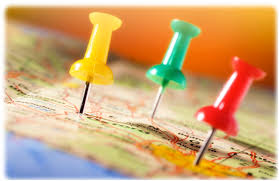 Welcome to a ‘Top Ten’ page devoted to South American offbeat travel hotspots we’ve experienced firsthand: ‘Must Rides’, ‘Must Sees’, ‘Must Dos’ across the continent along with some ideas for those essential dual purpose pannier items.
Welcome to a ‘Top Ten’ page devoted to South American offbeat travel hotspots we’ve experienced firsthand: ‘Must Rides’, ‘Must Sees’, ‘Must Dos’ across the continent along with some ideas for those essential dual purpose pannier items.
You’ll also find our Top Ten ‘Reasons to Travel’ as well as ‘Rider Tips’ aimed in part for women either in the ‘thinking stage’ of getting into riding or those relatively new to being astride two wheels. Each ‘Top Ten’ list isn’t ranked; if they’ve made the list means they get our thumbs up.
Top Ten: Riding Roads, South America
NB: An evolving list that focuses on the countries we’ve experienced firsthand to date: Argentina and Chile.
-
Carretera Austral, Ruta 7: Chile (approx. 1,240km)
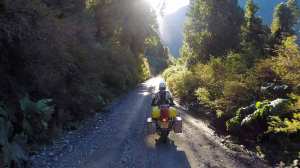 The Carretera Austral through Chile is a road that will satisfy your soul beyond conscious comprehension. It begins from the seaside town of Puerto Montt in the north where Chile’s Lakes District ends to the village of Villa O’Higgins in the south, snaking south for 1,240 kilometres into a land of dense forests, snow-tipped mountains, glacial streams, islands and swift-flowing rivers. Don’t let the potential wet and windy weather put you off (we rode it in May 2014).
The Carretera Austral through Chile is a road that will satisfy your soul beyond conscious comprehension. It begins from the seaside town of Puerto Montt in the north where Chile’s Lakes District ends to the village of Villa O’Higgins in the south, snaking south for 1,240 kilometres into a land of dense forests, snow-tipped mountains, glacial streams, islands and swift-flowing rivers. Don’t let the potential wet and windy weather put you off (we rode it in May 2014).
We spent a week riding Carretera Austral’s dirt roads, which was well worth the extra effort involved through the gravelly, muddy and corrugated parts. The pothole-peppered track took us hundreds of metres above sea level on Mount Jeinemeni, which gave us day long views of a lake the size of a city. It was so lofty from atop, I felt like I could see half the world. Mammoth-sized mountains engulfed us as well as voluminous lakes under even bigger skies.
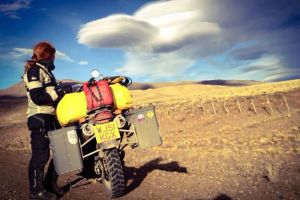 Everything was super-sized – the only missing piece of the jigsaw was the dinosaurs. Feeling like a dot in the landscape, we wound our way up. Everything was – the only missing piece of the jigsaw was the dinosaurs. Feeling like a dot in the landscape, we wound our way up and down the mountain passes taking extra care; there were no barriers on some of the steep hairpin bends, which were loose and corrugated to add to the fun and games. Some had described these mountain passes as “hair-raising on two wheels” although it was often so stunning, forgetting I was on more technical terrain was made easier.
Everything was super-sized – the only missing piece of the jigsaw was the dinosaurs. Feeling like a dot in the landscape, we wound our way up. Everything was – the only missing piece of the jigsaw was the dinosaurs. Feeling like a dot in the landscape, we wound our way up and down the mountain passes taking extra care; there were no barriers on some of the steep hairpin bends, which were loose and corrugated to add to the fun and games. Some had described these mountain passes as “hair-raising on two wheels” although it was often so stunning, forgetting I was on more technical terrain was made easier.

Further north past Chile Chico, the ground either side of the Carretera Austral changed dramatically where barren plains gave way to a grassy, lush landscape. The orange, reds and russet leaves of autumn were just appearing for us here. Soaking up the vegetation-dense vista was like having a sponge bath, it was good to drench the soul in something green for a change. Incredible. Queulat National Park is definitely worth the detour off the Carretera Austral too – here you’ll find The Hanging Glacier.
-
San Pedro de Atacama to Paso de Sico, Ruta 23: Chile (approx. 209km)

Some fantastic off road riding and your efforts over the loose gravel, stretches of sand and corrugations will reward you with a pastel watercolour painting scene of soft textures. The landscape is intermingled by a myriad of harmonious hues on the colour wheel. Chiefly creamy mochas, milk chocolate and swirling dark browns. You’ll chance upon Laguna Miscanti & Miniques. Two sparkling brackish lakes, one a blue curacao liqueur and the other starkly beautiful in its crystallised white but beckoning us by its inky midnight blue. En route, you’ll also come across Salar de Talar. A glittering salty lake in the same aquamarine blue found in the Indian Ocean and you’ll get to dangle your legs over the edge of iron red rocks, perfectly rounded and smoothed by the blasting winds. It’s possible enter Argentina at the border of Paso de Sico but remember to stamp your passport out in Chile’s San Pedro de Atacama, 145 miles away.
-
Susques to Salta, Ruta 51: Argentina (approx. 300km)
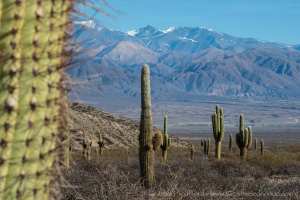
What you’re store for is an earthy, rollicking, lip licking feast of fun. In August 2014, we bobbled over loose gravel, frozen streams crusted over in ice, slushy mud and oodles of slippery sand. I imagine there wouldn’t be any ice in the summer months. The 176 mile ride was worth it just to see what I labelled ‘Boulder world’ alone, bestowed on us in its breathtaking enormity. There sat an incredibly impressive legion of stand-alone rocks bigger than an average sized house. Some were the size of ships. It was a movie set from Raiders of the Lost Ark. The unpaved road became a dirt road, which became a track and the track a mere suggestion of one. Both our bikes went down but survived the animated fun. Not for the faint hearted or those that prefer the smooth tarmac.
-
Zapala to Caviahue, Argentina (& if you’re feeling feisty onto Copahue), Argentina (approx. 173km)
 Imagine a wanderlust cocktail of Freddy Flintstone boulder-lined desert, mountain lakes and pehuén forests but best of all, monkey puzzle trees amid big snowy mountains dominating the landscape. Welcome to the road between Zapala and Caviahue. In the nineteenth century these evergreen coniferous trees, native to Chile, were named in response to a remark that an attempt to climb one would puzzle even a monkey, uh uoo!
Imagine a wanderlust cocktail of Freddy Flintstone boulder-lined desert, mountain lakes and pehuén forests but best of all, monkey puzzle trees amid big snowy mountains dominating the landscape. Welcome to the road between Zapala and Caviahue. In the nineteenth century these evergreen coniferous trees, native to Chile, were named in response to a remark that an attempt to climb one would puzzle even a monkey, uh uoo!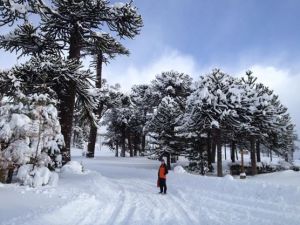
The roads left the senses tingling as we were riding into the onset of the ski season. In June 2014, we ventured the ten mile ride over on thick gravel ripio to Copahue. We’d heard the mud baths and hot natural springs were still open to invitation of the slightly crazed. I got four miles in when the dirt road dwindled to a pebbly thread, finally to a mere suggestion. The stones, slushy mud and injurious ice were too much for me although the return ride felt like a piece of cake with my back to the unwanted wind. I hear Copahue is a sight to behold, shame the snow prevented us from getting there. During the summer months, the ride to Copahue would be straight forward in easy conditions.
-
Ruta de los Siete Lagos – Seven Lakes Road, Argentina (approx. 107km)
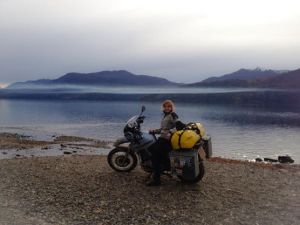 The Road of the Seven Lakes is the popular name given to the provincial route 234 between San Martín de los Andes and Villa La Angostura in the Neuquén Province, Argentina. Definitely not one to be missed, this is popular with folks on four wheels, two and on foot. The 107 km road that crosses the Lanín and Nahuel Huapi national parks provides access to several lakes in the forest area of the Patagonic Andes, as well as to other sights. The seven primary lakes of the road after which the route takes its name comprise:
The Road of the Seven Lakes is the popular name given to the provincial route 234 between San Martín de los Andes and Villa La Angostura in the Neuquén Province, Argentina. Definitely not one to be missed, this is popular with folks on four wheels, two and on foot. The 107 km road that crosses the Lanín and Nahuel Huapi national parks provides access to several lakes in the forest area of the Patagonic Andes, as well as to other sights. The seven primary lakes of the road after which the route takes its name comprise:
Machónico, Escondido, Correntoso, Espejo, Lácar, Falkner and Villarino. Other lakes accessible through secondary paths include the Meliquina, Hermoso, Traful and Espejo Chico lakes.
The lakes are aptly named for their salmon fishing, beauty, clarity and hidden aspects – we wouldn’t have missed this road even if it did feel a little wrong to be riding on so much asphalt through virgin coihue and colihue cane forests. The day’s song ended on a sweet note as we dared to hope that a steep trail would zig-zag us down to a mysterious looking lake. The day hit a harmonious crescendo as we stumbled upon it, Lago Lacar. A long, narrow bar of opaque blue mist hung beautifully over the freshwater. Behind me, I saw hills rising wild as far as the eye could see covered in trees that no axe had ever touched. I saw the sunlight glinting off the lake and clouds sweeping in from the west. I even saw a caracara circling. I waved at him as late afternoon drew upon us, shadows growing long. Dusk arrived and left to a tune of pinks and oranges. Overhead a half moon peeked out through the scuttling clouds, beneath which a stillness settled over my mind. The stars looked like eyes, watching over us in this secluded spot with only each other for company.
-
Cafayate to Cachi, Argentina (approx. 161km)

Via La Vuelta a los Valles – Return to the Valleys. Oh my, what a thrill ride waiting for you! Valles Calchaquies oozes a seductive, off the beaten track rugged landscape. We encountered: bee eaters flying above, gravelly sand, sandy gravel and well, more sand. Inevitably we stumbled through some rough patches of sand, me more than Jason. Vernacular architecture was common in the valleys that to my mind deserved some special attention – even I couldn’t fail to notice some of the adobe houses that boasted neoclassical columns and Moorish arches. Cachi was full of cobblestones, boasted a tranquil plaza overlooked by noble mountains and led us on a road that crossed the Parque National Los Cardones. Interestingly, the local furniture is made from the wood of cacti, cardon; in the treeless Andean foothills and puna. A superb little spot in the desert and one I’m glad we took the time to deviate from our route to Salta and discover.
-
Ruta 46 via Laguna Blanca to Zapala, Argentina (approx. 123km)
To my mind, Ruta 46 is in direct competition to the Carretera Austral. You won’t believe it until you see it. Church bells were chiming inside my head, rejoicing alongside the ring of a quieter alarm bell as to why this road is so unknown and underrated. It took us from one national park to another via a scenically steep mountain pass. We were riding 1,200 metres above sea level through big sky country where the striking volcanic deserts led us all the way to Laguna Blanca. The laguna was a drainage lake that formed when lava flows dammed two small streams; now host to coots, grebes, upland geese and the odd flamingo, primarily under protection for the black-necked swans. The road led us to Zapala, is a touristic city in the Patagonian province of Neuquén, Argentina for an overnight stop.
-
Puyehue National Park, Chile to Villa La Angostura, Argentina (approx. 100km)
Ruta 231 marked as the 215 on Google maps will lead you through Puyehue National Park, out of Chile and back into Argentina. After the 231 road, it appears on Google maps that the road comes to an abrupt halt. It doesn’t, refer to any good map and you’ll be taken on a road that most assuredly exists..! Around the sweeping roads you’ll ride, curving up around the mountains, back down until you’ll be hit by a powdery place of volcanic ash. Tall trees robbed of life and leaves perforate a thick carpet of brown flakes. For us, it was like riding through the land of the dead and apart from each other and the roar from our bikes, the world was awash in sepia. Nature woke up in Villa La Angostura, a village in the south of the Argentine province of Neuquén, on the northwest shore of the Nahuel Huapi Lake. It’s an upmarket town and ski resort.
-
Cachi to Salta, Argentina (approx. 160km)
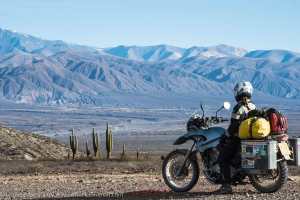
Your passage from Cachi to Salta will bestow the prettiest proliferation of cacti you might ever see. In the space of an afternoon, the diversity of landscape becomes borderline ludicrous, at least it did for us. One minute it felt as Mexico as cactus populated sandy plains can get and around a corner we peaked our ride at 3,300 metres to feast our eyes on Icelandic foothills. They looked completely covered in cocoa-powder – not what I expected after the desert scene previously encountered. You may like we did decide to deviate off road down a rocky track with the odd sheer drop and holes gaping in the road like hungry bites from a sandwich; it got the appetite primed for a perfect picnic spot at the bottom. Back up onto the main drag on ruta 33 and a few miles further along, you’ll enter a New Zealand inspired Lord of the Rings scene that alters into a sub-tropical rainforest, which in turn transforms into Scottish hills and lush green English farmland. All in the space of an afternoon. All in the smallest segment of South America – a slice of Argentinian pie I could continue to dine out on for months.
10. Mendoza to Barreal via Uspallata, Argentina (approx. 235km)
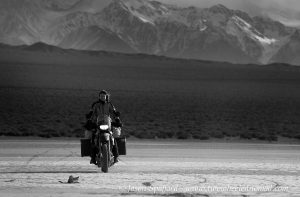
If you swing a right westward off ruta 40 back onto the 7 north towards Uspallata, it’ll give rise to quite a dramatic scene-stealer. Dense clusters of brooding clouds, dark grey steely skies and the purply presence of the Andes with hoarfrost gripping at every low level bush was as Wuthering Heights as you’re likely to see that side of the southern hemisphere. In July 2014, we got lucky and hit an unpaved track between the 39 and 412 roads – the first time I’d off-roaded smiling in a smattering of snow!
Arriving in Barreal that afternoon felt like someone had turned up the colour saturation in Photoshop. Up to then, I’d been blasé to the bland landscape of wind-tortured plains and dusty mountains, the appearance and texture of elephant skin and had no idea what lay around the corner. I’d read that this part of the San Juan province gave locals around 300 days of ultra-clear, pollution-free skies each year. Like a tap of a wand to a magician’s hat, out popped stark poplar trees against fiercely blue rivers running clear and an ancient dried out lakebed ‘La Pampa del Leoncito’. Every square centimetre of the 10 kilometre mud-flat was a pattern of cracked crazy-paving. It turned the colour of Maldivian sand when the sun shone down. Needless to say, we spent nigh on an afternoon simulating spirals, figure of eights and playful attempts at crop circles leaving only traces of our tyre-streaked fun. Back in open country, a blending of the soul took place once again by means of my motorcycle and me.
Top Ten: ‘Must Sees’, South America
NB: We’ve focused on Argentina and Chile having spent nine to ten months there.
1. Tierra del Fuego, Argentina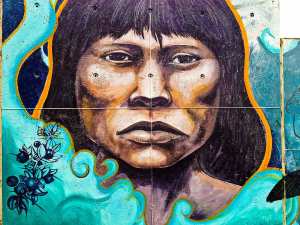
The southernmost city in the world, Ushuaia is the capital of Tierra del Fuego, Antártida e Islas del Atlántico Sur Province, Argentina. After some incredible hiking in this PATA-God-of-Peaks-GONIA, you surely won’t forget to have your photograph taken at the ‘Fin del el Mundo’ (End of the World) sign in Tierra del Fuego National Park – you may even spot a Fuegian red fox! While you’re there, why not indulge in a traditional asado with cordero (a barbeque with Patagonian lamb), visit the Harberton Estancia to learn all about missionary pioneer Tommy Bridges and the inspiring biologist Natalie Prosser whose museum she founded is home to some of the world’s finest specimens of whale, dolphin and other marine life. It would also be a missed opportunity not to visit the Ushuaia’s museums and immerse yourself in the lives of the Yámana and other Indian tribal peoples that lived in harmony for centuries.
2. Valle de la Luna – Valley of the Moon, Argentina
-
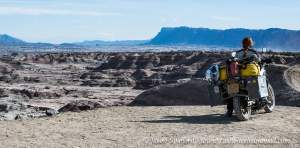
Valley of the moon Ischigualasto Provincial Park, also called Valle de la Luna is a provincial protected area in the north-east of San Juan Province, north-western Argentina, limiting to the north with the Talampaya National Park, in La Rioja Province. Valley of the moon is a 630 square km UNESCO park, a desert valley that sits between mountain ranges Cerros Colorados in the east and Cerro Los Rastros in the west.
We rode into a sandy scene of cacti and rock formations steeped in rich mineral layers: creamy white calcium, pistachio green copper, bile yellow sulphur and terracotta-tinged iron, which looked super-imposed against a cloudless blue sky. During a 40 km paid tour on us astride our bikes following a procession of cars, we listened intently to how complete specimens of dinosaur skeletons had been found from the Triassic period, preserved so perfectly inside the layered sedimentary rock infused with its safeguarding substances. Fortunately, our tour guide Florencia was relaxed and allowed us to hang back, disappearing from view more oft than not and foremost the throng of tourists.
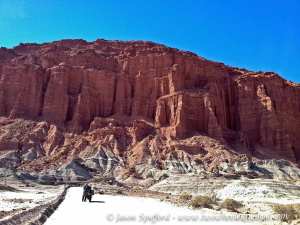
Over millennia at every meander in the canyon, the waters of the dry River Ischigualasto had carved shapes in the malleable red sandstone, monochrome clay and volcanic ash. I didn’t think much to the ‘submarine’ or ‘worm’ but rather liked the ‘Sphinx’ with an uncanny resemblance to a lion’s body wearing a woman’s head. It was an incredibly raw remnant of the Mesozoic Era, representing an ancient segment of our evolution. Riding around the place on two wheels was a fittingly first rate way to see the place although four wheels would suffice just as well.
3. Atacama desert, Chile

The Atacama Desert is a plateau in South America, covering a 1,000 km strip of land on the Pacific coast, west of the Andes mountains.t is the driest non-polar desert in the world. San Pedro de Atacama makes an ideal base for daily sorties including: Salar de Talar, Valley of the Moon, Laguna Chaxa – a flamingo breeding site, Laguna Cejar and Laguna Tebinquinche near Ojos del Salar sinkholes and ‘The Indian Stone’, a geological monolith, near Salar de Tararock. There’s a wealth of wonderful sights to see in the Atacama, the place really got under our skin.
-
El Tatio, Chile
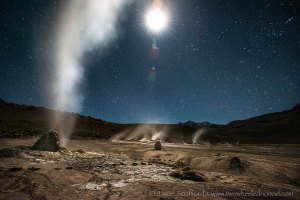
Geyser field, El Tatio. El Tatio is a geyser field located within the Andes Mountains of northern Chile at 4,320 meters above sea level. Its name means ‘the grandfather’. It is among the highest-elevation geyser fields in the world. You’ll be in geyser seventh heaven here. Fumaroles bubble all over the geyser field, plumes of scalding hot water gush upwards and arresting towers of steam rise from the rocks making a spectacular sight. There’s even a hot spring you can warm up your cockles in, it’s bliss. Just beware of early morning temperatures, which can go as low as -20 degrees Celsius! No one had a problem with us taking our wheels down onto the geyser field, we stayed mostly on the designated paths – what a rare ride out of the norm!
-
Salar de Uyuni, Bolivia
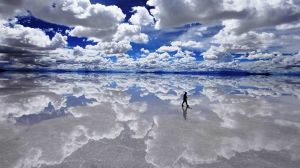
Salar de Uyuni is the world’s largest salt flat at 10,582 square km. Need I say more? It is located in the Potosí and Oruro departments in southwest Bolivia, near the crest of the Andes and is at an elevation of 3,656 metres above sea level. Superlatives are not needed for this astounding site…
-
Torres del Paine National Park, Chile
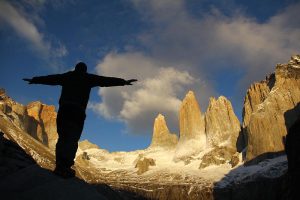
Torres del Paine – Towers of Paine.
Torres del Paine National Park is a national park encompassing mountains, glaciers, lakes, and rivers in southern Chilean Patagonia. What more could you ask for? The Cordillera del Paine is the centerpiece of the park. Hike the ‘W’ trail to get an intimate encounter with ‘The Horns’ and ‘The Towers’ but be warned, it’s an intense five day footslog of around 70 km. You may want to opt for the full ten day circuit, which lots do and love. Without stating the obvious, a
decent backpack and proper hiking boots are essential, I’d say so are dry bags too to hang your food in nearby trees when camping away from the pesky mice! The vistas however will have your soul singing so it’s worth the strenuous effort. Pack plenty of high-energy (lightweight) foods and second skins for those blisters.
-
Perito Moreno glacier, Los Glaciares National Park, Argentina
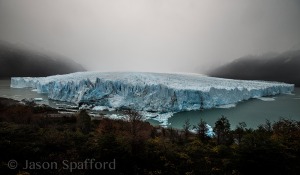
Perito Moreno glacier The neck-craning, jaw-dropping Perito Moreno Glacier is a glacier located in the Los Glaciares National Park in southwest Santa Cruz province, Argentina. It’s iconic and staggeringly beautiful that will send your heart soaring. The 250 km2 ice formation and 30 km in length, is one of 48 glaciers fed by the Southern Patagonian Ice Field located in the Andes system shared with Chile. This icefield is the world’s third largest reserve of fresh water. The Perito Moreno glacier, located 78 km from El Calafate, was named after the explorer Francisco Moreno, a pioneer who studied the region in the 19th century and played a major role in defending the territory of Argentina in the conflict surrounding the international border dispute with Chile.
-
Mount Fitz Roy, El Chaltén village between Argentina and Chile
The magnificent Monte Fitz Roy is a mountain located near El Chaltén village, in the Southern Patagonian
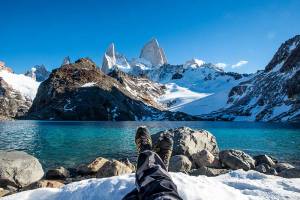 Ice Field in Patagonia, on the border between Argentina and Chile.
Ice Field in Patagonia, on the border between Argentina and Chile.Taking a pre-dawn hour-long hike up to Lake Capri will give you a good warm-up. It facilitates a rich opportunity to watch the sun rise over Mount Fitz Roy from afar, part of the Southern Patagonian Ice Field. We stayed until the first light bathed the tip of the peak at over 3,400 metres; its meringue smooth snow was the whitest I’d ever seen. It was bitterly cold in May 2014 first thing but the German, Dutch and Argentinian trio of chaps accompanying us agreed, it was well worth the chilly 14 km walked.
If you’re anything like us, you’ll be itching for a closer look. The two of us took the 25 km round trek over to Laguna de Los Tres. This was about the closest we were going to get to Mount Fitz Roy, which afforded the most intimate vantage point overlooking the lagoon. As soon as we’d caught our breath from the slog endured to climb up there, the sight took our breath away once more. The lagoon was incredible, so clear and gorgeous – it was all I could do not to leap into those placid waters. Mother have mercy though, we were walking on hot coals for the last ten miles to get back – plodding heavily down unforgiving stones salted with white on the snow-speckled trail. These peaks of Patagonia certainly make you earn it.
Peeling ourselves away from El Chaltén, we rode alongside the sun-flecked waters of Lago Argentina for what seemed like an eternity. This lake was at least fifty miles long. As sure as eggs are eggs though, the smooth tarmac gives way to more interesting gravelly terrain shortly before Lago Cardiel. Enjoy!
-
Mano del Desierto – The Hand of the Desert, Chile
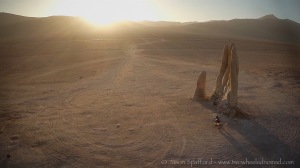
The morning light makes this place even more special. The Mano de Desierto is a large-scale sculpture of a hand located in the Atacama Desert in Chile, 75 km to the south of the city of Antofagasta, on the Pan American Highway. The nearest point of reference is the “Ciudad Empresarial La Negra”. A spectacular sight to behold at 11 metres high. It looked like a last vestige of a lost civilization. The entity as a whole put back an artful finesse into the striking sculpture that the mindless scribblings had tried to take away. Mario Irarrázabal the sculptor, symbolised the enigmatic sculpture as a sorrowful sentinel intended to evoke the tragic reality of the human condition. Emotions such as injustice, loneliness, human vulnerability and helplessness are embodied, it’s striking and unique.
10. Purmamarca, Argentina
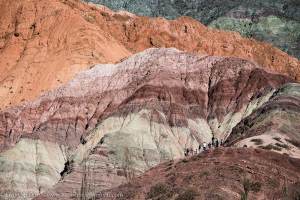
The Seven Coloured Hills of Purmamarca As a flyspeck town in the Tumbaya Department of the Jujuy Province, Purmamarca we re-labelled ‘Permanent marker’ is no broader than the tip of one. It sits against Cerro de los Siete Colores – the Hill of Seven Colours, which can only be described as a jagged rock formation resembling the marzipan fantasy of an over-zealous pastry chef. The village makes its coin by the congruent rainbow of colours interlaced through woven goods and handicrafts on offer. You could buy anything from a hat, poncho and slippers with a matching hippy handbag. A straggle of ochre adobe houses and age-old algarrobo trees next to a bijou 17th century church surrounded the hubbub of the central plaza. I loved weaving around the hills to get a better look at the place, coming away from the hordes of holiday-makers for a more relaxing ride by ourselves to just well, soak it all up.
-
Top Ten: Dual Purpose Pannier Items
With space at a premium on a motorcycle trip no matter how long the journey’s duration, shouldn’t everything your trusty steed has to carry have at least a dual purpose? Here is some food for thought:
-
A Satellite Navigation System
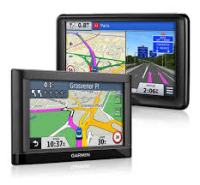
We like the trusty Garmin; although we don’t solely rely on the device – maps remain king – it still takes the stress out of navigating around big cities. Look for a GPSs that also comes with a nifty function to source the nearest petrol station, bank or lodging for example, which will prove priceless at the end of many a long day in the saddle. A worthy investment if you don’t wish to waste time trying to find your way out of a labyrinth that is your average big city.
-
Beer Can Stove

A stove can be made from any regular aluminium soft drinks or beer can, fueled by pure / rubbing alcohol sourced from most pharmacies and supermarkets. Genius idea and incredibly cheap to run, prevents your food tasting of gasoline too from other petrol-fuelled stoves.
Demo link
To complement your beer can stove, check out the Pro Nano Squad Cookset too. Cracking addition to your wild camp ensemble!
-
Motorcycle covers
We used a long length of elastic and ‘ripstop’ fabric to make our homemade motorcycle covers, traditionally used in
the making of parachutes. We fed the elastic through the bottom of a hem so they would cling onto the bottom of the bikes without fear of them being blown away in a gusty wind. The fabric is not rainproof although it will admirably
protect your motorbike from the elements; sand, dust, snow, volcanic ash etc. They also come in handy when you
 need to leave your bike unattended. The covers make our motorcycles practically invisible. The prying and over-curious eye is simply not drawn to two relatively big BMWs underneath as the covers give them both an indistinct entity. Perfect in developing countries or any big city you just don’t fancy pushing your luck. Furthermore, because of their size, the covers fit amply over hostel bed mattresses that look like they’ve seen cleaner days. They also stash up into a corner of a roll bag without taking too much bulky space and can even be used as a comfy pillow.
need to leave your bike unattended. The covers make our motorcycles practically invisible. The prying and over-curious eye is simply not drawn to two relatively big BMWs underneath as the covers give them both an indistinct entity. Perfect in developing countries or any big city you just don’t fancy pushing your luck. Furthermore, because of their size, the covers fit amply over hostel bed mattresses that look like they’ve seen cleaner days. They also stash up into a corner of a roll bag without taking too much bulky space and can even be used as a comfy pillow.
-
Luggage
Bags – Dry bags, a Roll bag and Lockable freezer bags:
In all sizes – keeping your stuff soggy-free and bone-dry at all times is essential, especially in the rainy season or over river-crossings. We find a 90 litre Ortlieb roll bag and thinner Exped dry bags in varying sizes keep our equipment, provisions, clothes and tech watertight and away from all the other dusty and sandy delights you encounter en route. I also love using lockable freezer bags as another layer of waterproof protection for my smaller items such as the rechargeable batteries, head torch, paperwork and wads of money travellers need to carry from country to country. Although the Exped bags are brilliant, they will be susceptible to wear and tear, some of ours have incurred little rips in them from all the bashing they endure when we’re off road.
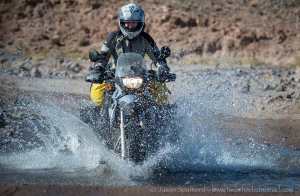
Panniers:
Hard or soft luggage, it’s a toughy! After much deliberation, we each opted for a pair of Metal Mule 38 litre hard aluminium panniers. Up to now, they’ve been bullet proof, have saved our legs when the bike goes down as well as the engine on my bike that doesn’t have crash bars. They offer instant security if you’re carrying some expensive items, no one has a clue what’s contained inside and they can also be used as a safe locked to hostel beds with an additional lock. We use the panniers as a table, stool and windbreak around the bikes when we’re wild camping under the stars.
-
Fake wallet
In the hopefully unlikely event of getting mugged, I like the idea of being able to reach for a ‘mugger’s wallet’ containing a small amount of the local currency in the country I’m travelling. It may just satisfy his or her instant gratification requirements keeping the bulk of your hard-earned dollar away from the robber’s hands.
-
Brown parcel or duct tape

How many times have I experienced a lid from a bottle that’s come loose and spilled all the contents of my bag or pannier? Use parcel or duct tape on practically everything to prevent untimely spillages: toiletries in general, jam jars, opened sachets of wet and dry food, milk bottles and cartons…you get the drift. I use tape on the end of the lead that connects to my heated clothing, which when not in use sits exposed. It saves the rain and dust perishing it. I also like having a roll of strong clear tape on me too, I can repair rips in our maps and protect my pannier stickers.
-
Free mobile phone applications
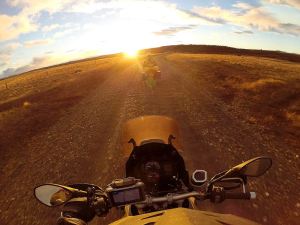
On the road to Harberton Estancia.
– The free ‘European Road Safety’ app contains all important road safety rules. Going to play in Europe? What is the speed limit on Spanish motorways? Do I need to wear a helmet when I cycle in Sweden? Download it before going abroad and save on roaming charges too. We rode from Nottingham to Antwerp via the Euro Tunnel to catch a container ship in Belgium, with our bikes taking us to Uruguay; having the ‘European Road Safety’ app proved useful.
– We also LOVE ‘Maps with me’ for detailed maps worldwide and its fabulously useful functions to search for local banks, hostels, camping etc. It’s amazing how often this comes in handy to supplement the detail on the SatNav.
– ‘Skycode Translate‘ is great for many language translations, an app that works offline and will translate paragraphs not just words. Plus, I’ve always liked having an offline dictionary in the local lingo (most are free). Saves weight and bulk in the panniers too.

– There’s also ‘Word Lens‘ that allows you to hover the camera on your mobile phone over some foreign text – a road sign or menu for example and it will transform the language into English for you. Just like that.
– I use ‘iTorch‘ as a strong illuminating beam when my head torch’s packed.
– I also tap into using ‘Duolingo‘ to help with my Spanish.
-
Dental floss

Believe it or not, we use dental floss not just to maintain our dental hygiene but as an ideal and strong material to substitute sewing thread for repairing items such as putting a button back on, darning your socks, cutting through cheese if you haven’t a knife handy, holes in the tent, repairing backpacks, wrapping up parcels, fishing line alternative, hanging items from a tree, a clothes line…the list is endless.
-
Motion Pro Trail tool

Unquestionably one of the finest all purpose tools ever designed. One of these and a Leatherman will dismantle over 80% of most bikes in minutes. It weighs nothing and replaces KGs of other tools.
Demo: https://www.youtube.com/watch?v=4QMsjjnUzFA
10. Motorcycle gear
Waterproof motorcycle boots:
We’re both wearing Sidi Adventure motorcycle boots as loathe the prospect of having wet feet all day. Saves having to don expensive breathable waterproof socks too, which although are superb in serving their purpose, will get smelly soon enough and at some point will need a fresh pair. I don’t want my feet to sweat either by wearing plastic bags. The Sidi boots offer amazing protection in all weathers and on the odd occasion I fall underneath or off my bike. They’re comfortable to wear astride the saddle all day although I wouldn’t climb a mountain in them.
Heated clothing: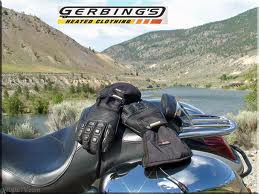
Anyone nesh travelling in nippy temperatures on two wheels should consider making the investment in heated clothing. We adore our Gerbing gloves and jacket; the heat allows us to ride for hours in sometimes sub-zero degrees and biting winds without batting an eyelid. Biking bliss in days when you get all seasons. And worth every penny. Gerbing offer a lifetime guarantee too on all the heating elements, which is a Brucey Bonus.
CamelBak:
The sun’s beating down like a fiery hot hammer and the temperatures are searing sometimes. Regardless whether it’s rain, hail or shine, I wouldn’t be without my CamelBak, a lightweight rucksack that houses 3 litres of water contained in a durable bladder. The system feeds into a valved hose that falls neatly over my right shoulder, ready for when I’m thirsty. The pack has just enough room for a light lunch, tissues and suncream. Perfect. Hydration levels safely attended, I am good to go for hours at a time without having to unpack the pannier and grab a drink to repack the pannier. This slim little bag is also invaluable on day walks and short sorties.
Top Ten: ‘Must Dos’, South America
NB: An evolving list that focuses on the countries we’ve experienced firsthand to date: Argentina and Chile.

Tantalise those tastebuds and experience the mouthwatering culinary delights of a traditional asado with Patagonian  cordero (lamb) and bifi (beef) and other carne (red meat), Argentina.
cordero (lamb) and bifi (beef) and other carne (red meat), Argentina.
Drink Mate with newfound or old Argentinian friends. Also known as yerba mate, chimarrão or cimarrón is a traditional South American caffeine-rich infused drink, particularly in Argentina where it is defined by law as the “national infusion”, Uruguay, Paraguay and Southern Brazil, and to a lesser degree in southern Chile, the Bolivian Chaco, Syria and Lebanon. It is prepared by steeping dried leaves of yerba mate in hot water.
Experience the German cultural influences in Puerto Varas, a city and commune located in the southern Chilean province of Llanquihue in the Los Lagos Region. Nearby is King of the South, Los Lagos region of Chile. A 2,652 metre tall 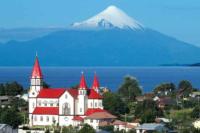 stratovolcano between Osorno and Llanquihue provinces. A volcano textbook conical in shape and looms imposingly over the emerald green waters of Lake Todos Los Santos and Lake Llanguihue.
stratovolcano between Osorno and Llanquihue provinces. A volcano textbook conical in shape and looms imposingly over the emerald green waters of Lake Todos Los Santos and Lake Llanguihue.
 Go to Puerto Madryn, a city in the province of Chubut in Argentine Patagonia. June to mid-December is when the southern right whales migrate to give birth here!
Go to Puerto Madryn, a city in the province of Chubut in Argentine Patagonia. June to mid-December is when the southern right whales migrate to give birth here!
Take yourself off on a wine tour to sample the world’s finest Malbec in Mendoza. Mendoza is the capital city of 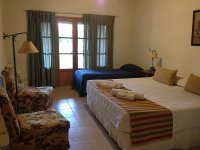 Mendoza Province, in Argentina. It is located in the northern-central part of the province, in a region of foothills and high plains, on the eastern side of the Andes. The award-winning nectar can be found in our favourite family vineyard Hacienda del Plata. We stayed at Posada Olivar, which was as secluded as it was special, breakfast was a fresh feast each morning, the bed was a super-king and the power shower a memorably massaging experience. It was such a welcomed break from our two wheeled nomadic life, it was a wrench to leave.
Mendoza Province, in Argentina. It is located in the northern-central part of the province, in a region of foothills and high plains, on the eastern side of the Andes. The award-winning nectar can be found in our favourite family vineyard Hacienda del Plata. We stayed at Posada Olivar, which was as secluded as it was special, breakfast was a fresh feast each morning, the bed was a super-king and the power shower a memorably massaging experience. It was such a welcomed break from our two wheeled nomadic life, it was a wrench to leave.
Learn enough Latin American Spanish to meet some locals, engage in the local culture and see where it takes you.
Go and get drenched in Iguazú National Park’s waterfalls Argentina, located in the Iguazú Department, in the north of the province of Misiones, Argentine Mesopotamia. It has an area of 550 km².

Bob on the surface of a salt dense waterhole in Chile’s Atacama desert, you’ll float like polystyrene!
Go and marvel at Licancabur volcano near San Pedro de Atacama, Chile – it won’t disappoint at around 6,000 metres tall.
Immerse yourself for a day in Santiago’s culture: National Museum of Fine Arts, Museum of Contemporary Art, Santiago Metropolitan Park, Santa Lucia Hill, San Cristobal Hill
Top Ten Reasons to Travel

1. Adventure! Unlike travelling, what you encounter during your 9-5 job may not always facilitate rich experiences from the unknown.
2. Travelling is fantastic soul food. Not only will travelling broaden your horizons, whet your appetite for more but it will increase your mindfulness to live in the ‘now’, as opposed to indulging in thoughts of where you think you should be in five or ten years’ time.
3. If travelling teaches anything, it’s that you shouldn’t always take a suspicious, weary approach with those you don’t know. Some of the most humbling times in your life will be down to acts of unconditional human kindness from total strangers.
4. Living out of a rucksack on a journey will bring the realisation that you need few possessions to be happy. It will reinforce to want what you’ve already got, rather than wanting what you don’t have.

5. Travelling makes you more interesting. Fact.
6. Leaving home soil to explore somewhere unfamiliar will increase your independence.
7. Immersing yourself in other peoples’ cultures by living a life outside the safe parameters of ‘home’ will inevitably give you a stronger appreciation for alternative ways of living and foremost, where you’ve come from. It’s amazing how you’ll realign your perspective of what’s important when you return home.
8. Your problem-solving skills will be tested, greatly improved upon and honed to a highly creative level. You will become more resourceful, better able to cope in a crisis and seek out help when needed. Problems can always get resolved, one way or another.
9. Travelling will invariably ensure you leave your comfort zone – a healthy endeavour for the mind and body.
10.You’ll never lie on your death bed wishing you had travelled less but spent more hours in the office.
Top Ten Rider Tips
Particularly aimed in part for women either in the ‘thinking stage‘ of getting into riding or those relatively new to being astride two wheels.
1. Stop procrastinating
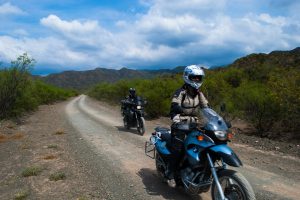
Just get on a bike and start riding. Don’t keep putting it off because sometimes later can become never. Your age is irrelevant. Don’t listen to all the risk-averse naysayers telling you how dangerous motorbikes can be. Adopting a defensive riding style will eliminate a lot of risk and hazards. Life’s for living, why not live it loudly? I was the least natural rider to begin with, crikey – if I can do it – anyone can. If you’re still stuck in the ‘thinking about it’ stage of getting into motorcycling, take a taster session. In a controlled environment with an instructor that comes recommended. Sometimes a female instructor can make the prospect of the experience less daunting. It’s much easier than you’ll imagine. If you can ride a push-bike, you can ride a motorbike.
2. For relatively new riders
Believe in yourself. Take the opportunity to learn from and practice with someone whose experience and patience is far-reaching. Find yourself a riding partner that doesn’t mind acting as your mentor too. Shadowing is a great way to learn. Ride as often as you can and even though you may go through a steep learning curve – occasionally feeling out of your comfort zone – keep riding. Be patient with yourself content in the knowledge that sooner rather than later, you’ll become a competent rider. Avoid task loading yourself on the road, instead practice in empty car parks away from all the distractions you encounter in traffic to hone your slow-speed skills. As well, go on lots of ride outs and practice, practice, practice!
3. Don’t be intimidated by the macho image
Yes, motorcycling is still male-dominated but ignore the stereotype of the big burly guy on his whopping 1200cc machine. And needing enduro / motocross training as a pre-requisite skill to ride a motorcycle, is a myth. There are increasingly more women taking to two wheels on smaller, lighter bikes. Get out of your own stereotype too and know women can ride just as easily as men.
4. Join the world of adventure motorcycling
 Find a local motorcycle club or find a few; make friends with other riders and there will be oodles of people eager to help and support you go from zero to lets go! Riding has opened up a whole world of excitement and life long friendship for me. Visit Horizons Unlimited’s website which is a premier source of information on motorcycle and overland adventure travel.
Find a local motorcycle club or find a few; make friends with other riders and there will be oodles of people eager to help and support you go from zero to lets go! Riding has opened up a whole world of excitement and life long friendship for me. Visit Horizons Unlimited’s website which is a premier source of information on motorcycle and overland adventure travel.
5. Buying the bike
Before buying a motorcycle, test ride as many as you can. Ask yourself what do you want your two wheels predominantly for. Although a personal choice, a smaller bike may be a good choice for commuting to and from work, ideal for negotiating through busy traffic. A touring bike capable of carrying significant luggage may appeal for longer distance road trips. Do you want to ride off road and therefore need good ground clearance? Is sitting upright astride the bike preferable, will you be carrying a pillion and do you require your trusty steed to give you sizeable mileage in between filling up – are other aspects to factor in. Spoked wheels can be easier to fix on the road than alloy ones is another consideration. Above all, choose a motorcycle that will meet your needs and capabilities.
6. Making it affordable
Don’t wait years to buy a motorcycle, lease one. Gear is easily rented too. Investing in good quality motorcycle clothing and a helmet is a must, whatever your budget. However, when you have the means why not buy a second hand bike? Having a used motorcycle will give you a lot more money for your trips. Academy of Adventures shares tips and hacks from everyday adventures.
7. Always wear protective gear
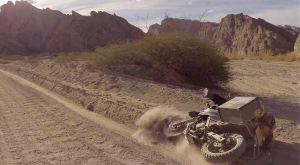 Never be tempted to omit wearing the full motorcycle gear and helmet for protection, no matter how glorious the weather or short the ride; you can wash sweat off at the end of the day, you can’t wash away ripped skin. Seek professional advice on the right headgear.
Never be tempted to omit wearing the full motorcycle gear and helmet for protection, no matter how glorious the weather or short the ride; you can wash sweat off at the end of the day, you can’t wash away ripped skin. Seek professional advice on the right headgear.
8. Ride the right bike for you
The right bike will scream at you once you’re on it. Start with something small and if you desire, progress slowly upwards. Don’t be railroaded into purchasing a big bike. If planning to motorcycle on your own, ride a bike that you can pick up fairly easily by yourself. It’s a misconception that you need to be tall to ride an average height motorbike although personal comfort on how you feel trumps all. However, you can lower the suspension, change the seat or even invest in a factory-lowered motorcycle if you wish. Some womens’ motorcycle boots will give you an extra inch in height.
9. Off roading course / advanced road riding course
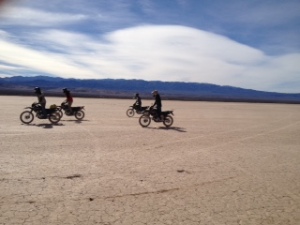 If you’re about to set off on a two-wheeled trip on home soil or further afield, you may not always be on smooth tarmac or amongst drivers that have heard of the Highway Code. Getting yourself on an off road course will help you to further understand your motorcycle in terms of handling, momentum, cornering and weight shifting to name just a few. It will familiarise you to coping: with inclines, declines, on gravel, dirt, through water, at height, perhaps even sand. Simon Pavey’s Off Road Skills in South Wales is one of many reputable schools; their two day course was the best investment I made before setting off on a big trip and transformed my road riding to boot. Likewise, an advanced road riding course will increase your personal safety on roads amid those crazy road users.
If you’re about to set off on a two-wheeled trip on home soil or further afield, you may not always be on smooth tarmac or amongst drivers that have heard of the Highway Code. Getting yourself on an off road course will help you to further understand your motorcycle in terms of handling, momentum, cornering and weight shifting to name just a few. It will familiarise you to coping: with inclines, declines, on gravel, dirt, through water, at height, perhaps even sand. Simon Pavey’s Off Road Skills in South Wales is one of many reputable schools; their two day course was the best investment I made before setting off on a big trip and transformed my road riding to boot. Likewise, an advanced road riding course will increase your personal safety on roads amid those crazy road users.
10. Going the extra mile
If you ride for long periods, consider boosting your derriere’s long term comfort in the saddle. There are some superb saddles, add-on inflatable cushion seats and treated sheepskins available. If riding in cooler climates, consider investing in after market heated handlebar grips if your bike doesn’t already have them. Riding with waning dexterity in your fingers can be dangerous, especially when braking / changing gear. Perhaps take it a step further and treat yourself to heated clothing. I adore my Gerbing jacket and gloves; when riding in chilly temperatures, I can ride for hours on end being mindful to the world without worrying about my personal comfort. It’s biking bliss.
Related resources:
Horizons Unlimited Motorcycle Travel
Ladies on the Loose – Part 4 of the Motorcycle Adventure Travel Guide series
Global Women Who Ride
Women Riders Now
BMW GS Girls
Global Motorcycle Adventures of Women Riders
Lois Pryce’s books

August 31, 2014 at 10:21 am
Really interested in your journey, adventures, tips – great write ups and superb photos. You met my son Ashley from Sussex, in Ushuaia when he had just sailed round Cape Horn. He has also been to and enjoyed many of the same places and journeys as you by motorbike, bus and boat. He is currently in the Amazon! Keep safe – and continue to enjoy 😊
August 31, 2014 at 1:22 pm
Hola Ashley’s mum, lovely of you to get in touch. What a nice surprise. We both loved meeting Ashley, I wrote about him in one of the Ushuaia posts as he made a great lasting impression on us. Think I described him as a gentle soul, I was very taken with him as he seemed very unruffled by life and didn’t have an aggressive bone in him. It’d be great to see him again and pick up where we left off. I’m looking forward to spending time in the Amazon, it would be rude not to go for a few weeks. My mum is close-ish to you in Surrey and regularly pops into Sussex to walk, both beautiful counties in that corner of the world. She’s a keen rambler. Lots of long distance and Latin American love, Lisa (& Jason) xxx
February 5, 2015 at 10:11 am
This is a very nice section and we will for sure use it when we start our South America trip next year. Thank you!
February 5, 2015 at 12:45 pm
All good stuff Michnus, SA is packed with unmissable roads…you’ll see L&J